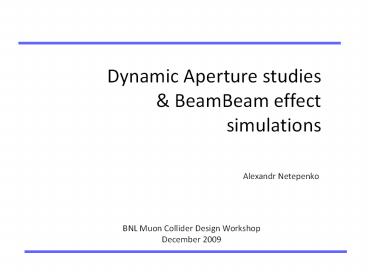Dynamic Aperture studies - PowerPoint PPT Presentation
1 / 7
Title:
Dynamic Aperture studies
Description:
Diagonal DA, MAD-8 calculation (4D tracking) for different constant dp/p, ... (as far as we have round beams, vertical tunesifts are the same) ... – PowerPoint PPT presentation
Number of Views:20
Avg rating:3.0/5.0
Title: Dynamic Aperture studies
1
Dynamic Aperture studies BeamBeam effect
simulations
Alexandr Netepenko
BNL Muon Collider Design Workshop December 2009
2
Dynamic Aperture vs Constant Momentum Deviation
DELTAP 0.005
DELTAP 0
DELTAP 0.005
1024 turns tracking using MAD-8 with lie4 method,
reference emittance
Beam-Beam element sizes computed with E?N25?,
November , 2009
A. Netepenko BNL MCD Workshop
2
3
Dynamic Aperture Radius vs Momentum Deviation
Diagonal DA, MAD-8 calculation (4D tracking) for
different constant dp/p, BeamBeam included, 1024
turns
MAD-X calculation 6D tracking with synchrotron
oscillations, no BeamBeam, 1024 turns
November , 2009
A. Netepenko BNL MCD Workshop
3
4
BeamBeam Element Simulation (Mathematica)
Number of slices 23
Thin lens model used
November , 2009
A. Netepenko BNL MCD Workshop
4
5
Iteratively Calculated new Beta-Functions
?First slice of the bunch (black dots)
(red dots represent initial beta-function)
?Middle slice of the bunch (black dots)
November , 2009
A. Netepenko BNL MCD Workshop
5
6
Calculated Tuneshifts for different slices in the
bunch
(as far as we have round beams, vertical
tunesifts are the same)
Dynamics of BeamBeam interaction in Mathematica
File
November , 2009
A. Netepenko BNL MCD Workshop
6
7
Goals
- Dynamic Aperture VS Momentum Acceptance
- (we can try to slightly reduce MA and gain DA
increase for nonzero dp/p) - DA VS dp/p calculations (4D MAD-8 Tracking)
(Done) - DA with synchrotron oscillations (MAD-X 6D
Tracking) (Done) - BeamBeam element simulations (Done)
- BeamBeam element with synchrotron oscillations
- Fringe fields influence (using SAD and MAD-X)
- Nonlinear field components in IR magnets
(systematic) - Random field errors and misalignments (very
important point for this - type of machine with huge beta-functions in IR)
November , 2009
A. Netepenko BNL MCD Workshop
7































